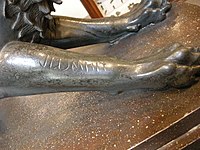Etruscan civilization
Etruscans 𐌓𐌀𐌔𐌄𐌍𐌍𐌀 Rasenna | |||||||||
|---|---|---|---|---|---|---|---|---|---|
| 900 BC[1]–27 BC[1] | |||||||||
 Extent of Etruscan civilization and the twelve Etruscan League cities. | |||||||||
| Status | City-states | ||||||||
| Common languages | Etruscan | ||||||||
| Religion | Etruscan | ||||||||
| Government | Chiefdom | ||||||||
| Legislature | Etruscan League | ||||||||
| Historical era | Iron Age, Ancient history | ||||||||
| 900 BC[1] | |||||||||
• Last Etruscan cities formally absorbed by Rome | 27 BC[1] | ||||||||
| Currency | Etruscan coinage (5th century BC onward) | ||||||||
| |||||||||
| Today part of | |||||||||
| History of Italy |
|---|
 |
|
|
The Etruscan civilization (/ɪˈtrʌskən/ ih-TRUS-kən) was an ancient civilization created by the Etruscans, a people who inhabited Etruria in ancient Italy, with a common language and culture who formed a federation of city-states.[2] After conquering adjacent lands, its territory covered, at its greatest extent, roughly what is now Tuscany, western Umbria, and northern Lazio,[3][4] as well as what are now the Po Valley, Emilia-Romagna, south-eastern Lombardy, southern Veneto, and western Campania.[5][6]
On the origins of the Etruscans a large body of literature has flourished; however, the consensus among modern scholars is that the Etruscans were an indigenous population.[7][8][9][10][11] The earliest evidence of a culture that is identifiably Etruscan dates from about 900 BC.[1] This is the period of the Iron Age Villanovan culture, considered to be the earliest phase of Etruscan civilization,[12][13][14][15][16] which itself developed from the previous late Bronze Age Proto-Villanovan culture in the same region,[17] part of the central European Urnfield culture system. Etruscan civilization dominated Italy until it fell to the expanding Rome beginning in the late 4th century BC as a result of the Roman–Etruscan Wars;[18] Etruscans were granted Roman citizenship in 90 BC, and only in 27 BC the whole Etruscan territory was incorporated into the newly established Roman Empire.[1]
The territorial extent of Etruscan civilization reached its maximum around 750 BC, during the foundational period of the Roman Kingdom. Its culture flourished in three confederacies of cities: that of Etruria (Tuscany, Latium and Umbria), that of the Po Valley with the eastern Alps, and that of Campania.[19][20] The league in northern Italy is mentioned in Livy.[21][22][23] The reduction in Etruscan territory was gradual, but after 500 BC, the political balance of power on the Italian peninsula shifted away from the Etruscans in favor of the rising Roman Republic.[24]
The earliest known examples of Etruscan writing are inscriptions found in
Legend and history




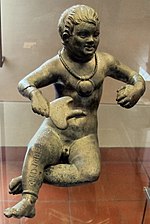

Ethnonym and etymology
The Etruscans called themselves Rasenna, which was shortened to Rasna or Raśna (Neo-Etruscan), with both etymologies unknown.[29][30][31]
In Attic Greek, the Etruscans were known as Tyrrhenians (Τυρρηνοί, Tyrrhēnoi, earlier Τυρσηνοί Tyrsēnoi),[32] from which the Romans derived the names Tyrrhēnī, Tyrrhēnia (Etruria),[33] and Mare Tyrrhēnum (Tyrrhenian Sea).[34][full citation needed]
The ancient Romans referred to the Etruscans as the Tuscī or Etruscī (singular Tuscus).
As for the original meaning of the root, *Turs-, a widely cited hypothesis is that it, like the word Latin turris, means "tower", and comes from the ancient Greek word for tower: τύρσις,[41][42] likely a loan into Greek. On this hypothesis, the Tusci were called the "people who build towers"[41] or "the tower builders".[43] This proposed etymology is made the more plausible because the Etruscans preferred to build their towns on high precipices reinforced by walls. Alternatively, Giuliano and Larissa Bonfante have speculated that Etruscan houses may have seemed like towers to the simple Latins.[44] The proposed etymology has a long history, Dionysius of Halicarnassus having observed in the first century B. C., "[T]here is no reason that the Greeks should not have called [the Etruscans] by this name, both from their living in towers and from the name of one of their rulers."[45] In his recent Etymological Dictionary of Greek, Robert Beekes claims the Greek word is a "loanword from a Mediterranean language," a hypothesis that goes back to an article by Paul Kretschmer in Glotta from 1934.[46][47]
Origins
Ancient sources
Literary and historical texts in the Etruscan language have not survived, and the language itself is only partially understood by modern scholars. This makes modern understanding of their society and culture heavily dependent on much later and generally disapproving Roman and Greek sources. These ancient writers differed in their theories about the origin of the Etruscan people. Some suggested they were Pelasgians who had migrated there from Greece. Others maintained that they were indigenous to central Italy and were not from Greece.
The first Greek author to mention the Etruscans, whom the Ancient Greeks called Tyrrhenians, was the 8th-century BC poet Hesiod, in his work, the Theogony. He mentioned them as residing in central Italy alongside the Latins.[48] The 7th-century BC Homeric Hymn to Dionysus[49] referred to them as pirates.[50] Unlike later Greek authors, these authors did not suggest that Etruscans had migrated to Italy from the east, and did not associate them with the Pelasgians.
It was only in the 5th century BC, when the Etruscan civilization had been established for several centuries, that Greek writers started associating the name "Tyrrhenians" with the "Pelasgians", and even then, some did so in a way that suggests they were meant only as generic, descriptive labels for "non-Greek" and "indigenous ancestors of Greeks", respectively.[51] The 5th-century BC historians Herodotus,[52] and Thucydides[53] and the 1st-century BC historian Strabo,[54] did seem to suggest that the Tyrrhenians were originally Pelasgians who migrated to Italy from Lydia by way of the Greek island of Lemnos. They all described Lemnos as having been settled by Pelasgians, whom Thucydides identified as "belonging to the Tyrrhenians" (τὸ δὲ πλεῖστον Πελασγικόν, τῶν καὶ Λῆμνόν ποτε καὶ Ἀθήνας Τυρσηνῶν). As Strabo and Herodotus told it,[55] the migration to Lemnos was led by Tyrrhenus / Tyrsenos, the son of Atys (who was king of Lydia). Strabo[54] added that the Pelasgians of Lemnos and Imbros then followed Tyrrhenus to the Italian Peninsula. According to the logographer Hellanicus of Lesbos, there was a Pelasgian migration from Thessaly in Greece to the Italian peninsula, as part of which the Pelasgians colonized the area he called Tyrrhenia, and they then came to be called Tyrrhenians.[56]
There is some evidence suggesting a link between the island of Lemnos and the Tyrrhenians. The
However, the 1st-century BC historian
For this reason, therefore, I am persuaded that the Pelasgians are a different people from the Tyrrhenians. And I do not believe, either, that the Tyrrhenians were a colony of the Lydians; for they do not use the same language as the latter, nor can it be alleged that, though they no longer speak a similar tongue, they still retain some other indications of their mother country. For they neither worship the same gods as the Lydians nor make use of similar laws or institutions, but in these very respects they differ more from the Lydians than from the Pelasgians. Indeed, those probably come nearest to the truth who declare that the nation migrated from nowhere else, but was native to the country, since it is found to be a very ancient nation and to agree with no other either in its language or in its manner of living.
The credibility of Dionysius of Halicarnassus is arguably bolstered by the fact that he was the first ancient writer to report the
The Romans, however, give them other names: from the country they once inhabited, named Etruria, they call them Etruscans, and from their knowledge of the ceremonies relating to divine worship, in which they excel others, they now call them, rather inaccurately, Tusci, but formerly, with the same accuracy as the Greeks, they called them Thyrscoï [an earlier form of Tusci]. Their own name for themselves, however, is the same as that of one of their leaders, Rasenna.
Similarly, the 1st-century BC historian
The Alpine tribes have also, no doubt, the same origin (of the Etruscans), especially the Raetians; who have been rendered so savage by the very nature of the country as to retain nothing of their ancient character save the sound of their speech, and even that is corrupted.
The first-century historian Pliny the Elder also put the Etruscans in the context of the Rhaetian people to the north, and wrote in his Natural History (AD 79):[60]
Adjoining these the (Alpine) Noricans are the Raeti and Vindelici. All are divided into a number of states. The Raeti are believed to be people of Tuscan race driven out by the Gauls, their leader was named Raetus.
Archeological evidence and modern etruscology
The question of Etruscan origins has long been a subject of interest and debate among historians. In modern times, all the evidence gathered so far by prehistoric and protohistoric archaeologists, anthropologists, and etruscologists points to an indigenous origin of the Etruscans.[7][8][9][10][11] There is no archaeological or linguistic evidence of a migration of the Lydians or Pelasgians into Etruria.[61][9][8][10][11] Modern etruscologists and archeologists, such as Massimo Pallottino (1947), have shown that early historians' assumptions and assertions on the subject were groundless.[62] In 2000, the etruscologist Dominique Briquel explained in detail why he believes that ancient Greek historians' writings on Etruscan origins should not even count as historical documents.[63] He argues that the ancient story of the Etruscans' 'Lydian origins' was a deliberate, politically motivated fabrication, and that ancient Greeks inferred a connection between the Tyrrhenians and the Pelasgians solely on the basis of certain Greek and local traditions and on the mere fact that there had been trade between the Etruscans and Greeks.[64][65] He noted that, even if these stories include historical facts suggesting contact, such contact is more plausibly traceable to cultural exchange than to migration.[66]
Several archaeologists specializing in
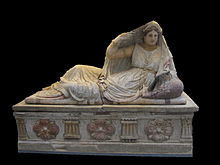
A 2012 survey of the previous 30 years' archaeological findings, based on excavations of the major Etruscan cities, showed a continuity of culture from the last phase of the Bronze Age (13th–11th century BC) to the Iron Age (10th–9th century BC). This is evidence that the Etruscan civilization, which emerged around 900 BC, was built by people whose ancestors had inhabited that region for at least the previous 200 years.
One of the most common mistakes for a long time, even among some scholars of the past, has been to associate the later Orientalizing period of Etruscan civilization with the question of its origins. Orientalization was an artistic and cultural phenomenon that spread among the Greeks themselves, and throughout much of the central and western Mediterranean, not only in Etruria.[70] Orientalizing period in the Etruscans was due, as has been amply demonstrated by archeologists, to contacts with the Greeks and the Eastern Mediterranean and not to mass migrations.[71] The facial features (the profile, almond-shaped eyes, large nose) in the frescoes and sculptures, and the depiction of reddish-brown men and light-skinned women, influenced by archaic Greek art, followed the artistic traditions from the Eastern Mediterranean, that had spread even among the Greeks themselves, and to a lesser extent also to other several civilizations in the central and western Mediterranean up to the Iberian Peninsula. Actually, many of the tombs of the Late Orientalizing and Archaic periods, such as the Tomb of the Augurs, the Tomb of the Triclinium or the Tomb of the Leopards, as well as other tombs from the archaic period in the Monterozzi necropolis in Tarquinia, were painted by Greek painters or, in any case, foreigner artists. These images have, therefore, a very limited value for a realistic representation of the Etruscan population.[72] It was only from the end of the 4th century BC that evidence of physiognomic portraits began to be found in Etruscan art and Etruscan portraiture became more realistic.[73]
Genetic research

There have been numerous biological studies on the Etruscan origins, the oldest of which dates back to the 1950s when research was still based on blood tests of modern samples and DNA analysis, including the analysis of ancient samples, was not yet possible.
An archeogenetic study focusing on the question of Etruscan origins was published in September 2021 in the journal
The conclusions of the 2021 study are in line with a 2019 study previously published in the journal
Among the older studies, only based on mitochondrial DNA, a mtDNA study, published in 2018 in the journal
A couple of
An earlier mtDNA study published in 2004, based on about 28 samples of individuals, who lived from 600 to 100 BC, in
In the collective volume Etruscology published in 2017, British archeologist Phil Perkins, echoing an earlier article of his from 2009, provides an analysis of the state of DNA studies and writes that "none of the DNA studies to date conclusively prove that [the] Etruscans were an intrusive population in Italy that originated in the Eastern Mediterranean or Anatolia" and "there are indications that the evidence of DNA can support the theory that Etruscan people are autochthonous in central Italy".[75][76]
In his 2021 book, A Short History of Humanity, German geneticist
Periodization of Etruscan civilization
The Etruscan civilization begins with the early Iron Age
Chronology
| Etruscan civilization (900–27 BC)[1] |
Villanovan period (900–720 BC) |
Villanovan I | 900–800 BC |
| Villanovan II | 800–720 BC | ||
| Villanovan III (Bologna area) | 720–680 BC[94] | ||
| Villanovan IV (Bologna area) | 680–540 BC[94] | ||
| Orientalizing period (720–580 BC) |
Early Orientalizing | 720–680 BC | |
| Middle Orientalizing | 680–625 BC | ||
| Late Orientalizing | 625–580 BC | ||
| Archaic period (580–480 BC) |
Archaic | 580–480 BC | |
| Classical period (480–320 BC) |
Classical | 480–320 BC | |
| Hellenistic period (320–27 BC) |
Hellenistic | 320–27 BC |
Expansion
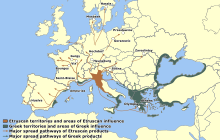
Etruscan expansion was focused both to the north beyond the
Around 540 BC, the Battle of Alalia led to a new distribution of power in the western Mediterranean. Though the battle had no clear winner, Carthage managed to expand its sphere of influence at the expense of the Greeks, and Etruria saw itself relegated to the northern Tyrrhenian Sea with full ownership of Corsica. From the first half of the 5th century BC, the new political situation meant the beginning of the Etruscan decline after losing their southern provinces. In 480 BC, Etruria's ally Carthage was defeated by a coalition of Magna Graecia cities led by Syracuse, Sicily. A few years later, in 474 BC, Syracuse's tyrant Hiero defeated the Etruscans at the Battle of Cumae. Etruria's influence over the cities of Latium and Campania weakened, and the area was taken over by Romans and Samnites.
In the 4th century BC, Etruria saw a Gallic invasion end its influence over the Po Valley and the Adriatic coast. Meanwhile, Rome had started annexing Etruscan cities. This led to the loss of the northern Etruscan provinces. During the Roman–Etruscan Wars, Etruria was conquered by Rome in the 3rd century BC.[95][96]
Etruscan League
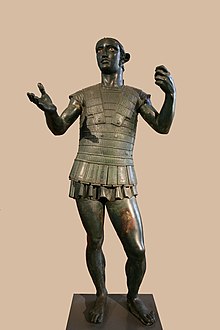
According to legend,
There were two other Etruscan leagues ("Lega dei popoli"): that of Campania, the main city of which was Capua, and the Po Valley city-states in northern Italy, which included Bologna, Spina and Adria.[99]
Possible founding of Rome

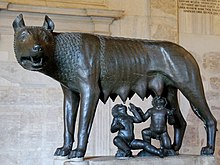
Those who subscribe to a Latin foundation of Rome followed by an Etruscan invasion typically speak of an Etruscan "influence" on Roman culture – that is, cultural objects which were adopted by Rome from neighboring Etruria. The prevailing view is that Rome was founded by Latins who later merged with Etruscans. In this interpretation, Etruscan cultural objects are considered influences rather than part of a heritage.[100] Rome was probably a small settlement until the arrival of the Etruscans, who constructed the first elements of its urban infrastructure such as the drainage system.[101][102]
The main criterion for deciding whether an object originated at Rome and traveled by influence to the Etruscans, or descended to the Romans from the Etruscans, is date. Many, if not most, of the Etruscan cities were older than Rome. If one finds that a given feature was there first, it cannot have originated at Rome. A second criterion is the opinion of the ancient sources. These would indicate that certain institutions and customs came directly from the Etruscans. Rome is located on the edge of what was Etruscan territory. When Etruscan settlements turned up south of the border, it was presumed that the Etruscans spread there after the foundation of Rome, but the settlements are now known to have preceded Rome.
Etruscan settlements were frequently built on hills – the steeper the better – and surrounded by thick walls. According to
Later history relates that some Etruscans lived in the Vicus Tuscus,[103] the "Etruscan quarter", and that there was an Etruscan line of kings (albeit ones descended from a Greek, Demaratus of Corinth) that succeeded kings of Latin and Sabine origin. Etruscophile historians would argue that this, together with evidence for institutions, religious elements and other cultural elements, proves that Rome was founded by Etruscans.
Under Romulus and Numa Pompilius, the people were said to have been divided into thirty curiae and three tribes. Few Etruscan words entered Latin, but the names of at least two of the tribes – Ramnes and Luceres – seem to be Etruscan. The last kings may have borne the Etruscan title lucumo, while the regalia were traditionally considered of Etruscan origin – the golden crown, the sceptre, the toga palmata (a special robe), the sella curulis (curule chair), and above all the primary symbol of state power: the fasces. The latter was a bundle of whipping rods surrounding a double-bladed axe, carried by the king's lictors. An example of the fasces are the remains of bronze rods and the axe from a tomb in Etruscan Vetulonia. This allowed archaeologists to identify the depiction of a fasces on the grave stele of Avele Feluske, who is shown as a warrior wielding the fasces. The most telling Etruscan feature is the word populus, which appears as an Etruscan deity, Fufluns.
Roman families of Etruscan origin
- Ancharia gens
- Arruntia gens
- Caecinia gens
- Caelia gens
- Caesennia gens
- Ceionia gens
- Cilnia gens
- Herminia gens – Patrician
- Erucia gens
- Lartia gens – Patrician
- Perpernia gens
- Persia gens
- Rasinia gens
- Sanquinia gens
- Spurinnia gens
- Tapsennia gens
- Tarquinia gens – Patrician (?)
- Tarquitia gens – Patrician
- Urgulania gens
- Verginia gens – Patrician
- Volumnia gens – Patrician
Society
Government

The historical Etruscans had achieved a
The government was viewed as being a central authority, ruling over all tribal and clan organizations. It retained the power of life and death; in fact, the
Family
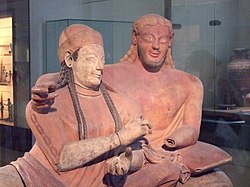
The princely tombs were not of individuals. The inscription evidence shows that families were interred there over long periods, marking the growth of the aristocratic family as a fixed institution, parallel to the gens at Rome and perhaps even its model. The Etruscans could have used any model of the eastern Mediterranean. That the growth of this class is related to the new acquisition of wealth through trade is unquestioned. The wealthiest cities were located near the coast. At the center of the society was the married couple, tusurthir. The Etruscans were a monogamous society that emphasized pairing.
Similarly, the behavior of some wealthy women is not uniquely Etruscan. The apparent promiscuous revelry has a spiritual explanation. Swaddling and Bonfante (among others) explain that depictions of the nude embrace, or symplegma, "had the power to ward off evil", as did baring the breast, which was adopted by
Military
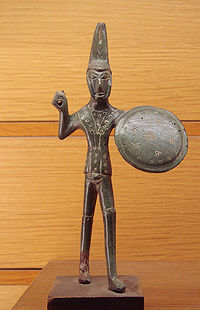
The Etruscans, like the contemporary cultures of Ancient Greece and Ancient Rome, had a significant military tradition. In addition to marking the rank and power of certain individuals, warfare was a considerable economic advantage to Etruscan civilization. Like many ancient societies, the Etruscans conducted campaigns during summer months, raiding neighboring areas, attempting to gain territory and combating piracy as a means of acquiring valuable resources, such as land, prestige, goods, and slaves. It is likely that individuals taken in battle would be ransomed back to their families and clans at high cost. Prisoners could also potentially be sacrificed on tombs to honor fallen leaders of Etruscan society, not unlike the sacrifices made by Achilles for Patrocles.[106][107][108]
Cities
The range of Etruscan civilization is marked by
That many Roman cities were formerly Etruscan was well known to all the Roman authors. Some cities were founded by Etruscans in prehistoric times, and bore entirely Etruscan names. Others were colonized by Etruscans who Etruscanized the name, usually Italic.[107]
Culture
Agriculture
The Etruscans were aware of the techniques of water accumulation and conservation in Egypt, Mesopotamia and Greece. They built canals and dams to irrigate the land, drained and reclaimed swamps. The archaeological remains of this infrastructure are still evident in around the maritime south western parts of Tuscany.[109]
Vite maritata is a viticulture technique exploiting Companion planting named after the Maremma region of Italy which may be relevant to climate change.[110] It was developed around the area by these early predecessors of the Romans who cultivated plants in as nearly as possible in their natural habit. The vines from which wine is made are a kind of liana that naturally intertwine with trees such as maples or willows.[111]
Religion
The Etruscan system of belief was an
Ruling over this pantheon of lesser deities were higher ones that seem to reflect the
Architecture
Relatively little is known about the architecture of the ancient Etruscans. They adapted the native Italic styles with influence from the external appearance of
Art and music
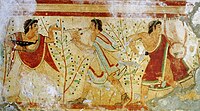

Etruscan art was produced by the Etruscan civilization between the 9th and 2nd centuries BC. Particularly strong in this tradition were figurative sculpture in terracotta (particularly lifesize on sarcophagi or temples), wall-painting and metalworking (especially engraved bronze mirrors). Etruscan sculpture in cast bronze was famous and widely exported, but few large examples have survived (the material was too valuable, and recycled later). In contrast to terracotta and bronze, there was apparently little Etruscan sculpture in stone, despite the Etruscans controlling fine sources of marble, including Carrara marble, which seems not to have been exploited until the Romans. Most surviving Etruscan art comes from tombs, including all the fresco wall-paintings, a minority of which show scenes of feasting and some narrative mythological subjects.[115]
Bucchero wares in black were the early and native styles of fine Etruscan pottery. There was also a tradition of elaborate Etruscan vase painting, which sprung from its Greek equivalent; the Etruscans were the main export market for Greek vases. Etruscan temples were heavily decorated with colorfully painted terracotta antefixes and other fittings, which survive in large numbers where the wooden superstructure has vanished. Etruscan art was strongly connected to religion; the afterlife was of major importance in Etruscan art.[116]
The Etruscan musical instruments seen in frescoes and bas-reliefs are different types of pipes, such as the
.Language

Etruscans left around 13,000
Literature
Etruscan texts, written in a space of seven centuries, use a form of the
See also
| Ancient history |
|---|
| Preceded by prehistory |
|
References
Citations
- ^ ISBN 978-8820348700.
- hdl:10023/24245.
- ISBN 978-1901663907.
- ISBN 0-7156-3162-4.
- ^ Camporeale, Giovannangelo, ed. (2001). The Etruscans Outside Etruria. Translated by Hartmann, Thomas Michael. Los Angeles: Getty Trust Publications (published 2004).
- ISBN 9788882653330.
- ^ ISBN 978-0-631-22038-1.
- ^ ISBN 9781444337341.
- ^ ISBN 978-1-61451-520-3.
- ^ ISBN 9781780238623.
- ^ ISBN 978-8862623049.
- ^ ISBN 978-8878145337.
Il termine "Villanoviano" è entrato nella letteratura archeologica quando, a metà dell '800, il conte Gozzadini mise in luce le prime tombe ad incinerazione nella sua proprietà di Villanova di Castenaso, in località Caselle (BO). La cultura villanoviana coincide con il periodo più antico della civiltà etrusca, in particolare durante i secoli IX e VIII a.C. e i termini di Villanoviano I, II e III, utilizzati dagli archeologi per scandire le fasi evolutive, costituiscono partizioni convenzionali della prima età del Ferro
- ^ ISBN 9788843022618.
- ^ a b Colonna, Giovanni (2000). "I caratteri originali della civiltà Etrusca". In Torelli, Mario (ed.). Gi Etruschi (in Italian). Milano: Bompiani. pp. 25–41.
- ^ a b Briquel, Dominique (2000). "Le origini degli Etruschi: una questione dibattuta fin dall'antichità". In Torelli, Mario (ed.). Gi Etruschi (in Italian). Milano: Bompiani. pp. 43–51.
- ^ a b Bartoloni, Gilda (2000). "Le origini e la diffusione della cultura villanoviana". In Torelli, Mario (ed.). Gi Etruschi (in Italian). Milano: Bompiani. pp. 53–71.
- ^ ISBN 0842523340.
- ^ ISBN 9780521684958.
- ^ "A good map of the Italian range and cities of the culture at the beginning of its history". mysteriousetruscans.com.
- ^ The topic of the "League of Etruria" is covered in Freeman, pp. 562–65.
- ".
- ^ Polybius. "Campanian Etruscans mentioned". II.17.
- WikiSourceor other Internet sites. As the work has already been done by Dennis and Thayer, the complete work-up is not repeated here.
- ISBN 0-312-38395-9.
- ISBN 0719055407.
- ^ "Etruscan alphabet and language". omniglot.com. Retrieved 2022-02-16.
- ^ Sassatelli, Giuseppe. "Celti ed Etruschi nell'Etruria Padana e nell'Italia settentrionale" (PDF) (in Italian).
- ^ federix71 (2019-08-28). "Etruschi e Celti della Gallia meridionale – parte 1". CelticWorld (in Italian). Retrieved 2022-02-15.
{{cite web}}: CS1 maint: numeric names: authors list (link) - ^ Rasenna comes from Dionysius of Halicarnassus. Roman Antiquities. I.30.3. The syncopated form, Rasna, is inscriptional and is inflected.
- ^ The topic is covered in Pallottino, p. 133.
- ^ Some inscriptions, such as the cippus of Cortona, feature the Raśna (pronounced Rashna) alternative, as is described at Bodroghy, Gabor Z. "Origins". The Palaeolinguistic Connection. Etruscan. Archived from the original on 16 April 2008.
- Perseus Project.
- Perseus Project.
- ^ Gaffiot's.
- ^ According to Félix Gaffiot's Dictionnaire Illustré Latin Français, the major authors of the Roman Republic (Livy, Cicero, Horace, and others) used the term Tusci. Cognate words developed, including Tuscia and Tusculanensis. Tuscī was clearly the principal term used to designate things Etruscan; Etruscī and Etrusia/Etrūria were used less often, mainly by Cicero and Horace, and they lack cognates.
- ^ According to the "Online Etymological Dictionary". the English use of Etruscan dates from 1706.
- Perseus Project.
- ^ Weiss, Michael. "'Cui bono?' The beneficiary phrases of the third Iguvine table" (PDF). Ithaca, New York: Cornell University. Archived (PDF) from the original on 2022-10-09.
- ^ Carl Darling Buck (1904). Introduction: A Grammar of Oscan and Umbrian. Boston: Gibb & Company.
- ISBN 9780517414255.)
{{cite book}}: CS1 maint: location missing publisher (link - ^ a b The Bonfantes (2003), p. 51.
- ^ τύρσις in Liddell and Scott.
- ^ Partridge (1983)
- ISBN 978-0719055409.
- ^ Book I, Section 30.
- ^ Beekes, R. Etymological Dictionary of Greek Brill (2010) pp.1520-1521
- ^ Kretschmer, P. "Nordische Lehnwörter im Altgriechischen" in Glotta 22 (1934) pp. 110 ff.
- ^ Hesiod, Theogony 1015.
- ^ Homeric Hymn to Dionysus, 7.7–8
- ^ John Pairman Brown, Israel and Hellas, Vol. 2 (2000) p. 211
- ^ Strabo. Geography. Book VI, Chapter II. Perseus Digital Library. Tufts University. Archived from the original on 2 September 2022. Retrieved 2 September 2022.
- ^ 6.137
- ^ 4.109
- ^ a b Strabo. Geography. Book V, Chapter II. Perseus Digital Library. Tufts University.Archived from the original on 2 September 2022. Retrieved 2 September 2022.
- ^ 1.94
- ^ Dionysius of Halicarnassus. Roman Antiquities. 1.28–3.
- ^ Morritt, Robert D. (2010). Stones that Speak. p. 272.
- ^ a b Dionysius of Halicarnassus. Roman Antiquities. Book I, Chapters 30 1.
- Ab Urbe Condita Libri[The History of Rome]. Book 5.
- ^ Plinius Secundus, Gaius. Naturalis Historia, Liber III, 133 (in Latin).
- ISBN 9780195170726.
Etruscan origins lie in the distant past. Despite the claim by Herodotus, who wrote that Etruscans migrated to Italy from Lydia in the eastern Mediterranean, there is no material or linguistic evidence to support this. Etruscan material culture developed in an unbroken chain from Bronze Age antecedents. As for linguistic relationships, Lydian is an Indo-European language. Lemnian, which is attested by a few inscriptions discovered near Kamania on the island of Lemnos, was a dialect of Etruscan introduced to the island by commercial adventurers. Linguistic similarities connecting Etruscan with Raetic, a language spoken in the sub-Alpine regions of northeastern Italy, further militate against the idea of eastern origins.
- ^ Pallottino, Massimo (1947). L'origine degli Etruschi (in Italian). Rome: Tumminelli.
- ^ Briquel, Dominique (2000). "Le origini degli Etruschi: una questione dibattuta sin dall'antichità". In Torelli, Mario (ed.). Gli Etruschi (in Italian). Milan: Bompiani. pp. 43–51.
- ISBN 9780191016752.
Briquel's convincing demonstration that the famous story of an exodus, led by Tyrrhenus from Lydia to Italy, was a deliberate political fabrication created in the Hellenized milieu of the court at Sardis in the early 6th cent. BCE.
- ISBN 978-0-415-67308-2.
- ^ Briquel, Dominique (1990). "Le problème des origines étrusques". Lalies. Sessions de linguistique et de littérature (in French). Paris: Presses de l'Ecole Normale Supérieure (published 1992): 7–35.
- ^ ISBN 978-2-7283-1138-5.
- ^ Bagnasco Gianni, Giovanna. "Origine degli Etruschi". In Bartoloni, Gilda (ed.). Introduzione all'Etruscologia (in Italian). Milan: Ulrico Hoepli Editore. pp. 47–81.
- ^ Stoddart, Simon (1989). "Divergent trajectories in central Italy 1200–500 BC". In Champion, Timothy C. (ed.). Centre and Periphery – Comparative Studies in Archaeology. London and New York: Taylor & Francis (published 2005). pp. 89–102.
- ^ Burkert, Walter (1992). The Orientalizing Revolution: Near Eastern Influence on Greek Culture in the Early Archaic Age. Enciclopedia del Mediterraneo. London: Thames and Hudson.
- ^ d'Agostino, Bruno (2003). "Teorie sull'origine degli Etruschi". Gli Etruschi. Enciclopedia del Mediterraneo (in Italian). Vol. 26. Milan: Jaca Book. pp. 10–19.
- ^ de Grummond, Nancy Thomson (2014). "Ethnicity and the Etruscans". Companion to Ethnicity in the Ancient Mediterranean. Chichester, Uk: John Wiley & Sons. pp. 413–414.
The facial features, however, are not likely to constitute a true portrait, but rather partake of a formula for representing the male in Etruria in Archaic art. It has been observed that the formula used—with the face in profile, showing almond-shaped eyes, a large nose, and a domed up profile of the top of the head—has its parallels in images from the eastern Mediterranean. But these features may show only artistic conventions and are therefore of limited value for determining ethnicity.
- ^ Bianchi Bandinelli, Ranuccio (1984). "Il problema del ritratto". L'arte classica (in Italian). Roma: Editori Riuniti.
- ISBN 978-0-470-71493-5.
- ^ ISBN 978-1934078495.
- ^ ISBN 978-0861591732. 173.
- ISBN 9780198821250.
"But mitochondrial DNA only records information on the entirely female line, a tiny fraction of the many tens of thousands of lineages that have contributed to any person's genome. To understand what really happened in an individual's history, it is incomparably more valuable to examine all ancestral lineages together."
- PMID 34559560.
- ^ PMID 31699931.
Interestingly, although Iron Age individuals were sampled from both Etruscan (n=3) and Latin (n=6) contexts, we did not detect any significant differences between the two groups with f4 statistics in the form of f4(RMPR_Etruscan, RMPR_Latin; test population, Onge), suggesting shared origins or extensive genetic exchange between them.
- ^ Antonio et al. 2019, p. 3.
- ^ Antonio et al. 2019, p. 2.
- ^ Antonio et al. 2019, Table 2 Sample Information, Rows 33-35.
- S2CID 52161000.
- PMID 15125046.
Seven Etruscan skulls were found in Corneto Tarquinia in the years 1881 and 1882 and were given as [a] present to Rostock's anatomical collection in 1882. The origin of the Etruscans who were contemporary with the Celts is not yet clear; according to Herodotus they had emigrated from Lydia in Asia Minor to Italy. To fit the Etruscan skulls into an ethnological grid they were compared with skeletal remains of the first thousand years B.C.E. All skulls were found to be male; their age ranged from 20 to 60 years, with an average age of about thirty. A comparison of the median sagittal outlines of the Etruscan skulls and the contemporary Hallstatt-Celtic skulls from North Bavaria showed that the former were shorter and lower. Maximum skull length, minimum frontal breadth, ear bregma height, bizygomatical breadth and orbital breadth of the Etruscan skulls were statistically significantly less developed compared to Hallstatt-Celtics from North Bavaria. In comparison to other contemporary skeletal remains the Etruscan skulls had no similarities in common with Hallstatt-Celtic skulls from North Bavaria and Baden-Württemberg but rather with Hallstatt-Celtic skulls from Hallstatt in Austria. Compared to chronologically adjacent skeletal remains the Etruscan skulls did not show similarities with Early Bronze Age skulls from Moravia but with Latène-Celtic skulls from Manching in South Bavaria. Due to the similarities of the Etruscan skulls with some Celtic skulls from South Bavaria and Austria, it seems more likely that the Etruscans were original inhabitants of Etruria than immigrants.
- PMID 23405165.
- PMID 23900768.
- ^ PMID 15015132.
- PMID 15457405.
- S2CID 19958417.
- PMID 16701432.
- ISBN 9780593229422.
It's likely that Basque, Paleo-Sardinian, Minoan, and Etruscan developed on the continent in the course of the Neolithic Revolution. Sadly, the true diversity of the languages that once existed in Europe will never be known.
- ^ a b Gilda Bartoloni, "La cultura villanoviana", in Enciclopedia dell'Arte Antica, Treccani, Rome 1997, vol. VII, p. 1173 e s 1970, p. 922. (Italian)
- ^ Walter Burkert, The Orientalizing Revolution: Near Eastern Influence on Greek Culture in the Early Archaic Age, 1992.
- ^ a b Giovanna Bermond Montanari (2004). "L'Italia preromana. I siti etruschi: Bologna" (in Italian). Treccani. Retrieved October 12, 2019.
- ^ ISBN 978-0-8143-1813-3. Retrieved 2009-04-22 – via Google Books.
- ^ ISBN 978-0-8425-2334-9. Retrieved 22 April 2009 – via Google Books.
- ^ Livy VII.21
- ^ "Etruschi" [Etruscans]. Dizionario di storia (in Italian). Treccani. Retrieved 29 March 2016.
- ^ a b "The Etruscan League of 12". mysteriousetruscans.com. 2 April 2009. Retrieved 25 April 2015.
- ISBN 9780203642276. Retrieved 2011-09-14.
- ISBN 978-0534582272.
The later Romans' own grandiose picture of the early days of their city was intended to glamorize its origins, but only with the arrival of the Etruscans did anything like an urban center begin to develop.
- ^ Hughes (2012). Rome: A cultural, visual, and personal history. p. 24.
Some Roman technical achievements began in Etruscan expertise. Though the Etruscans never came up with an aqueduct, they were good at drainage, and hence they were the ancestors of Rome's monumental sewer systems.
- ^ Tacitus, Cornelius. The Annals & The Histories. Trans. Alfred Church and William Brodribb. New York, 2003.
- ISBN 2842776585.
- ^ ISBN 9789188992970
- ^ a b Torelli, Mario (2000). The Etruscans. Rizzoli International Publications.
- ^ a b Dupey, Trevor. The Harper Encyclopedia of Military History. Rizzoli Harper Collins Publisher.
- ^ Dora Jane Hamblin (1975). The Etruscans. Time Life Books.
- ^ "The Etruscans and agriculture". Un Mondo Ecosostenibile. 21 November 2022. Archived from the original on Jan 13, 2024.
- ^ Limbergen, Dimitri Van (2024-01-04). "Ancient Roman wine production may hold clues for battling climate change". The Conversation. Archived from the original on Feb 29, 2024.
- ^ Mazzeo, Jacopo (June 6, 2023). "Vite Maritata, an Ancient Vine-Growing Technique, Makes a Comeback". Wine Enthusiast Magazine. Archived from the original on Jan 13, 2024.
- ^ a b Grummond, De; Thomson, Nancy (2006). Etruscan Mythology, Sacred History and Legend: An Introduction. University of Pennsylvania Museum of Archaeology.
- ^ ISBN 978-0-292-70687-3– via Google Books.
- ^ Boëthius, Axel; Ling, Roger; Rasmussen, Tom (1994). Etruscan and early Roman architecture. Yale University Press.
- ^ "I banchetti etruschi" (in Italian). Retrieved 24 November 2021.
- ^ Spivey, Nigel (1997). Etruscan Art. London: Thames and Hudson.
- ^ Massimo Pallottino, La langue étrusque Problèmes et perspectives, 1978.
- ^ Mauro Cristofani, Introduction to the study of the Etruscan, Leo S. Olschki, 1991.
- ^ Romolo A. Staccioli, The "mystery" of the Etruscan language, Newton & Compton publishers, Rome, 1977.
- ISBN 9781444337341.
- Varro, De lingua Latina, 5.55.
- ^ Maras, Daniele F. (2015). "Etruscan and Italic Literacy and the Case of Rome". In Bloome, W. Martin (ed.). A Companion to Ancient Education. Chichester, UK: John Wiley & Sons. p. 202.
- ^ Nielsen, Marjatta; Rathje, Annette. "Artumes in Etruria—the Borrowed Goddess". In Fischer-Hansen, Tobias; Poulsen, Birte (eds.). From Artemis to Diana: The Goddess of Man and Beast. Copenhagen: Museum Tusculanum Press. p. 261.
A massive Greek impact is clear especially in the coastal territory, which has led many to believe that the Etruscans were entirely Hellenized. Countless depictions show that Greek myths were, indeed, adopted and well-known to the Etruscans.
Sources
- Antonio, Margaret L.; et al. (November 8, 2019). "Ancient Rome: A genetic crossroads of Europe and the Mediterranean". PMID 31699931.
Further reading
- Bartoloni, Gilda (ed). Introduzione all'Etruscologia (in Italian). Milan: Hoepli, 2012.
- Sinclair Bell and Carpino A. Alexandra (eds). A Companion to the Etruscans, Oxford; Chichester; Malden, MA: Wiley Blackwell, 2016.
- Bonfante, Giuliano and Bonfante Larissa. The Etruscan Language: An Introduction. Manchester: Manchester University Press, 2002.
- Bonfante, Larissa. Out of Etruria: Etruscan Influence North and South. Oxford: B.A.R., 1981.
- Bonfante, Larissa. Etruscan Life and Afterlife: A Handbook of Etruscan Studies. Detroit: Wayne State University Press, 1986.
- Bonfante, Larissa. Etruscan Myths. London: British Museum Press, 2006.
- Briquel, Dominique. Les Étrusques, peuple de la différence, series Civilisations U, éditions Armand Colin, Paris, 1993.
- Briquel, Dominique. La civilisation étrusque, éditions Fayard, Paris, 1999.
- De Grummond, Nancy T. (2014). Ethnicity and the Etruscans. In McInerney, Jeremy (ed.). A Companion to Ethnicity in the Ancient Mediterranean. Chichester, UK: John Wiley & Sons, Inc. pp. 405–422.
- Haynes, Sybille. Etruscan Civilization: A Cultural History. Los Angeles: J. Paul Getty Museum, 2000.
- Izzet, Vedia. The Archaeology of Etruscan Society. New York: Cambridge University Press, 2007.
- Naso, Alessandro (ed). Etruscology, Berlin, Boston: De Gruyter, 2017.
- Pallottino, Massimo. Etruscologia. Milan: Hoepli, 1942 (English ed., The Etruscans. David Ridgway, editor. Bloomington, IN: Indiana University Press, 1975).
- Shipley, Lucy. The Etruscans: Lost Civilizations, London: Reaktion Books, 2017.
- Smith, C. The Etruscans: a very short introduction , Oxford: Oxford University Press, 2014.
- Spivey, Nigel. Etruscan Art. New York: Thames and Hudson, 1997.
- Swaddling, Judith and Philip Perkins. Etruscan by Definition: The Culture, Regional, and Personal Identity of the Etruscans: Papers in Honor of Sybille Haynes. London: British Museum, 2009.
- * Torelli, M. (ed.) (2001) The Etruscans. London.
- Turfa, Jean MacIntosh(ed). The Etruscan World. London: Routledge, 2013.
- Turfa, Jean MacIntosh. The Etruscans. In Farney, Gary D.; Bradley, Gary (eds.). The Peoples of Ancient Italy. Berlin: De Gruyter. pp. 637–672.
Cities and sites
- (Soprintendenza per i Beni Archeologici dell'Umbria) "The Cai Cutu Etruscan tomb" An undisturbed late Etruscan family tomb, reused between the 3rd and 1st century BC, reassembled in the National Archeological Museum of Perugia
- Hypogeum of the Volumnis digital media archive (creative commons-licensed photos, laser scans, panoramas), data from a University of Ferrara/CyArkresearch partnership
External links
- "Etruscan weapons and warfare". Archived from the original on 30 January 2016. Retrieved 3 November 2017.
- "Etruscan Lion Plaque Pendant". Archived from the original on 9 May 2017. Retrieved 2 February 2002.
- Nancy Thomson de Grummond. "Britannica. Ancient Italic people: the Etruscans". Chicago: Encyclopædia Britannica. Retrieved 21 September 2023.


